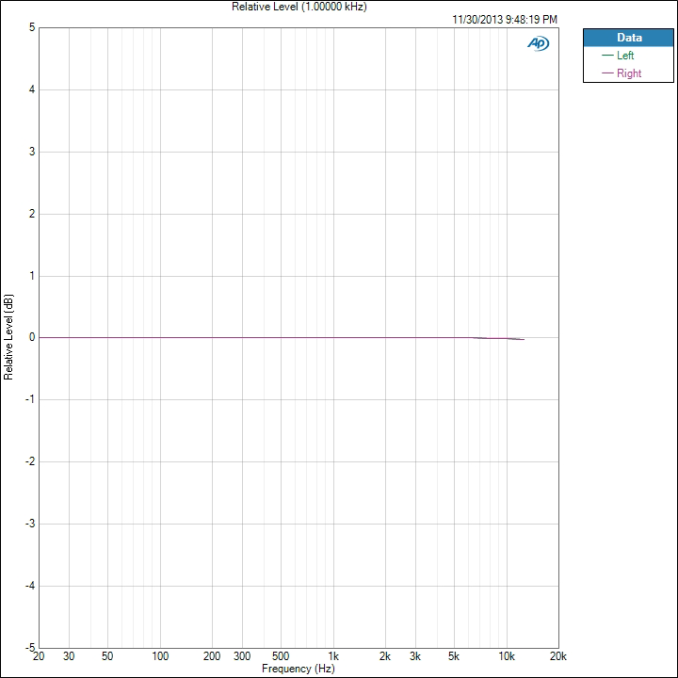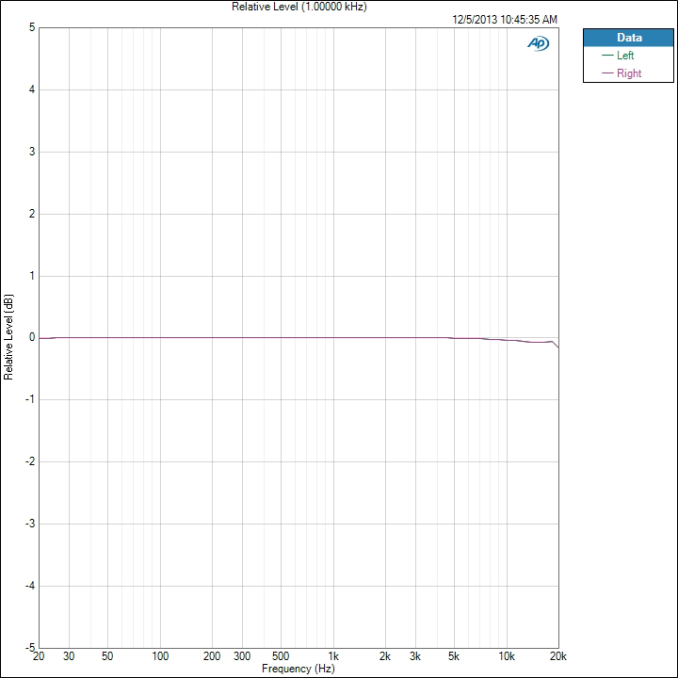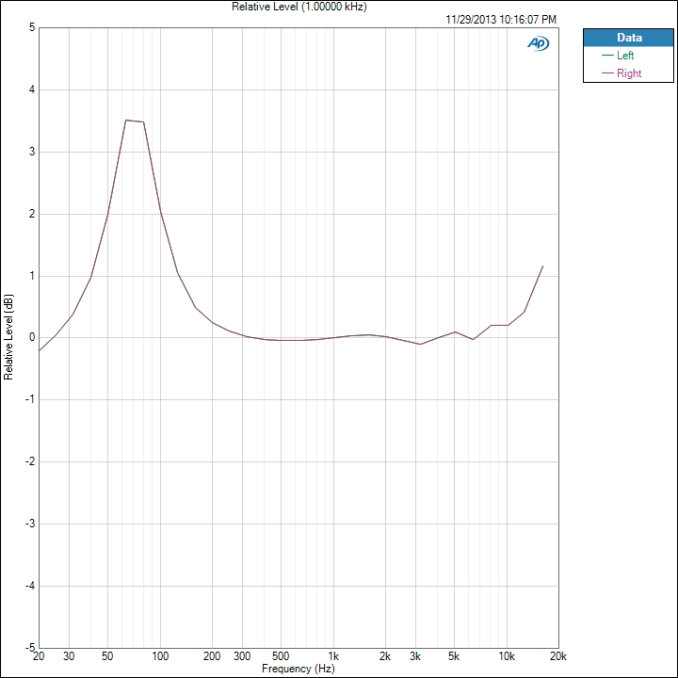Smartphone Audio Quality Testing
by Chris Heinonen on December 8, 2013 5:15 PM EST- Posted in
- Smartphones
- Audio
- Mobile
- Tablets
- Testing
Maximum Level
The maximum output level is derived from the 1kHz test tone used to determine THD+N. The higher the output from the headphone jack, the louder it can drive a pair of headphones. More importantly, having more power available means when you have dynamic music passages that call for power you are less likely to clip the waveform.
There is no chart to show here, just a number that the Audio Precision gives us. In our test data, the most powerful phone was the iPhone 5, at 32.46 mW of power. Next is the Nexus 5 at 22.24 mW, though we can’t drive it that high. Then the Note 3 at 11.81 mW and finally the Galaxy S4 at 3.895 mW. Doubling the power, from 4 mW to 8 mW, produces a 3 dB increase in volume level. 3 dB is the smallest change in volume levels we can easily hear. So even though the iPhone 5 produces 32 mW vs. 4 mW, that is only a 9 dB difference in volume. 10 dB is doubling the volume, so it isn’t even twice as loud. If you have demanding headphones, you will want as much power as you can get.
Frequency Response
To measure the frequency response we measure a set of 61 tones from 20 Hz to 20 kHz. All of these are then equalized to 1 kHz so we can see the maximum deviation from that level. An ideal phone will be perfectly flat here and allow you to adjust this with an EQ setting, or though your taste in headphones. On this test our best performing phone is the Galaxy S4, as seen here.
The total variation from 1 kHz is only 0.014 dB which is very good. The worst performing phone is the iPhone 5, but its variation is only 0.089 dB.
The iPhone 5 also picked up the 20 kHz tone while the Samsung and many others missed it. If we dropped this tone then it might be just as flat. The iPhone 5 test was run slightly differently, as it can't run the Android test program, which might account for this. For a phone with a different response, here is the HTC One with Beats enabled. Other HTC One testing is still in progress as I write this article.
Here we see that Beats is adding a +3.5 dB boost from 60 Hz to 90 Hz, but the deviation from 0 dB goes from 30Hz to 300 Hz. Past 6.5 kHz we also see a rise in the treble. People often mistake boosted treble for extra detail, which is likely the reasoning behind this. As we see it is far different than the other two examples we looked at.













188 Comments
View All Comments
psuedonymous - Monday, December 9, 2013 - link
Any chance of a test/roundup of bluetooth receivers?Impulses - Monday, December 9, 2013 - link
I'd love to see that.deathdemon89 - Monday, December 9, 2013 - link
I do hope you consider providing the audio tests in the main review on the day it's published, as opposed to tacking it on later. I usually read reviews only once, i.e. on the day they are published and don't keep returning to individual reviews looking for updates, so this would be a major data point readers like me would not be able to take advantage of.DanNeely - Monday, December 9, 2013 - link
I wouldn't hold my breath. Chris H isn't a typical smartphone reviewer. As a result getting these results at initial launch time would require either buying additional sets of test equipment for the reviewers, buying an additional phone for Chris H to do audio testing on, or delaying the article to ship the phone to Chris H after completing the rest of the testing work.Audio precision won't let you see pricing information without creating an account on their website. That suggests it's painfully expensive and that getting multiple copies of the hardware won't happen. Getting multiple copies of the phone isn't cheap either and is probably not going to happen except perhaps for a few halo devices. With the peanut gallery raging about any reviews that don't make it out on release day, I'm doubtful that anandtech would choose to delay reviews for a few days for a specialized test.
Impulses - Monday, December 9, 2013 - link
Ehh, I agree, if it's not realistic to have this testing the day the review is out it's no big deal... If it's a deal breaker for you then you'd wait the same amount of time either way, and if it's not (probably the majority of readers) then there's no point in making the rest wait.xaml - Saturday, December 14, 2013 - link
"Chris H isn't a typical smartphone reviewer. As a result getting these results at initial launch time would require either buying additional sets of test equipment for the reviewers, buying an additional phone for Chris H to do audio testing on, or delaying the article to ship the phone to Chris H after completing the rest of the testing work."Or buying an additional Chris H...
cheinonen - Monday, December 9, 2013 - link
Having this on the day-of is going to be a challenge for a number of reasons.- Brian is in Arizona, and I'm in Oregon. If there is only a single review sample, I have to get it from him.
- As mentioned, the Audio Precision is ridiculously expensive. I think the APx 582 used starts at $19,000 before adding the HDMI, Bluetooth, and Digital modules I use (I need it for receivers as well). Audio Precision is just a few minutes from my house and they've been nice enough to let me come in, test everything there, and endlessly bother their QA people to get this right. However, as I have to come in I have to schedule that, and it takes time.
- That also makes it far easier to do a batch of these at a time than one at a time. If I had at APx at home it would be easier but right now that's not possible.
So we will try to get all the data, as fast as possible, into the system, but day-of is going to be a logistical challenge. I'd rather have it be accurate than be fast.
cheinonen - Thursday, December 12, 2013 - link
OK, I shouldn't say ridiculously expensive. However, the instrument we use costs enough that it's not feasible for us to have them for myself, Anand, Brian, and everyone else that needs one for testing. The Audio Precision gear ranges from $6K to $50K+ depending on what you need and the price still means we can't outfit everyone with one. So testing will happen as fast as possible, but likely won't run with the reviews when they are initially posted.Bobs_Your_Uncle - Monday, December 9, 2013 - link
This audio bench is a tool of truly significant value to anyone hoping to arrive at the best, most fully informed purchasing decision possible. Given the respect & high regard that AT has earned throughout the tech sector, this audio initiative raises the bar for more than smartphone manufacturers alone.Along these lines, does AT have any plans to initiate a similar audio bench for the various motherboard lines that have recently implemented enhanced audio capabilities?
These are very positive steps toward driving advances in fundamental, yet long neglected platform capabilities. However, as improvements in audio reproduction are realized, there will still remain one critical, & seemingly intractable obstacle to overcome; What's it going to take for the recording industry to give up on compression & adopt a regimen of decent mastering.?
It'd be a shame if the only thing audiophile-grade tech revealed was just how badly most studios butcher great music through compression & lousy mastering.
Impulses - Monday, December 9, 2013 - link
I think that battle's beyond Anandtech'srealm, though the more cognizant the average reader/listener is the better.